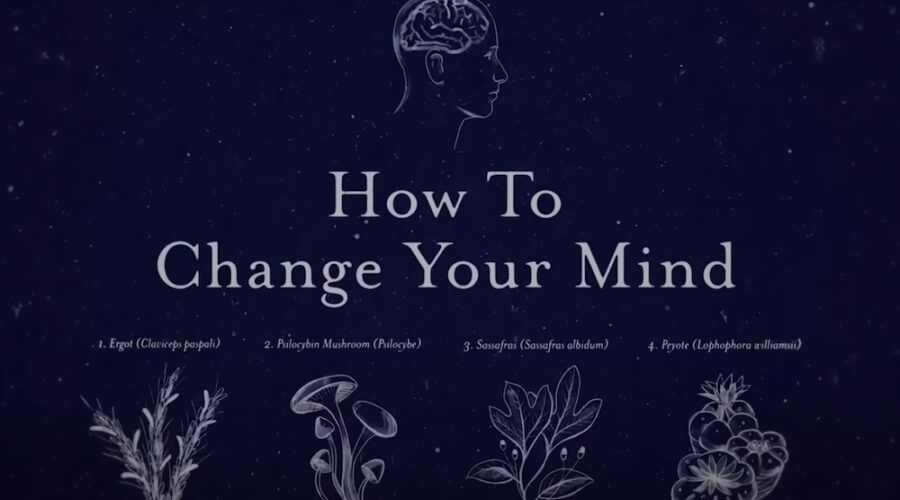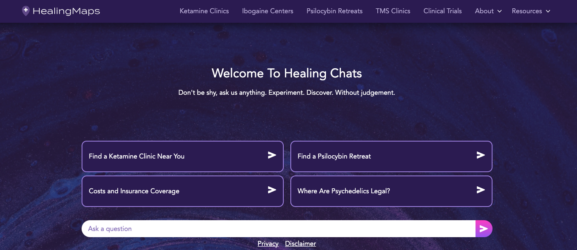The 7 Biggest Takeaways From Netflix’s ‘How To Change Your Mind’
How to Change Your Mind is a four-part Netflix series on psychedelics with 100 percent on Rotten Tomatoes, 8/10 on IMDB, and five stars on the astral plane. Why? Partly because psychedelics are hot right now.
But it isn’t the first time.
If we are to understand the present moment in psychedelics, it is important to learn about their past history of use and study. This is what author, gonzo journalist, and hardcore horticulturalist, Michael Pollan, sets out to explain.
As Pollan discovered when he was writing the New Yorker article that would become the book (that would become the Netflix series), the field of psychedelic research was thriving in the 1950s and 60s in the West. Over 1,000 scientific articles were published about LSD between 1950 and 1965. LSD was found to have positive effects on creativity in Silicon Valley. And, in fact, its addiction-curing potential was even endorsed by the founder of Alcoholics Anonymous.
Ready to explore a new horizon in mental health? Try out the beta version of HealingChat, HealingMaps AI chatbot that takes all our vetted content, clinics and retreats to answer all your questions in a safe environment. Try the beta version now!
Psilocybin was also widely studied in the years leading up to its prohibition. The Spring Grove Clinic had been using it to treat anxiety in cancer patients for a decade. That all ended in 1970 when the DEA listed both as Schedule I narcotics, banning psychedelic therapy overnight.
A similar thing would happen to MDMA 15 years later. After being rediscovered by Alexander Shulgin in the 1970s, MDMA was introduced to the psychiatric community by Leo Zeff, who came out of retirement to train other psychotherapists in its use. Like LSD and psilocybin, MDMA entered the counterculture in the early-80s, and by 1985 the DEA had made it a Schedule I substance too.
Mescaline is as long lasting as LSD, works similarly to MDMA as a phenethylamine, and has a history of indigenous use like psilocybin. It’s also a Schedule 1 drug, but unlike the others, the law exempts members of the Native American Church, who revere it as a sacred medicine.
Each episode in How to Change Your Mind examines one of these psychedelic compounds. It’s a fascinating ride through science, history, and culture.
Here were seven big takeaways from the show.
How to Change Your Mind Shows How Special MDMA Is
As explained by scientist Paul Daley at the beginning of Chapter 3 of How to Change Your Mind, MDMA both is and is not a psychedelic. Only after taking psychedelics can someone fully understand how it is both “a psychedelic” and “not a psychedelic”.
LSD, psilocybin and mescaline, Daley says, all have a similar mechanism of action. They work on the brain’s serotonin 2A receptors — which is responsible for their psychedelic effect, according to beliefs.
However, MDMA, is different. It causes the brain to release “a flood of serotonin,” creating feelings of openness and “loving connection to others.” But, as we learned in Chapter 1, the meaning of the term “psychedelic” is literally “mind-manifesting”, and in this sense of the word, MDMA certainly qualifies.
So, perhaps like ketamine, MDMA is not a psychedelic in the chemical sense but in the experiential sense, it is.
RELATED: The 10 Best Psychedelic Documentaries
LSD Has Wound Up Where It Began: Switzerland
Switzerland has some fine exports: Clocks, chocolate, army knives and… LSD.
The drug was first synthesized in 1938 by Swiss chemist Albert Hofmann, and it’s in Switzerland that LSD research has been revived. Following a conference held in Oslo in 2006 to celebrate Hofmann’s 100th birthday, psychiatrist Peter Gasser was given approval by Swiss authorities to research how the effects of LSD might be helpful in treating the anxiety felt by people with life-threatening illnesses. The results of the study were very promising.
In Chapter 1 of How to Change Your Mind on Netflix, a story features a patient participating in a different Swiss study who suffers from cluster headaches. With the help of LSD, we are told, the patient — whose headaches had caused him to lose his hair and to consider assisted suicide — has had five pain-free days. Despite promising studies from the 1950s between LSD and alcoholism, LSD research is not ongoing in America. This is partly due to heavy countercultural controversy.
“LSD is a psychedelic drug which occasionally causes psychotic behavior in people who have NOT taken it” according to, ironically enough, Timothy Leary. Also LSD therapy requires a therapist to work longer hours due to LSD’s lengthier trip time. American therapists may have the patients but not the patience for 12-hour sessions.
Mysticism Can Be Quantified… And The More The Merrier
In Chapter 2 of How to Change Your Mind, psychopharmacologist Roland Griffiths tells us that, when it comes to psychedelics, he believes in data. And, according to the data, an awful lot of people consider their experience with psilocybin to be the “single most spiritually-significant experience of their entire lifetime.”
Scientists want to quantify this, however. So, apparently, mysticism can be quantified by a Mystical Experience Questionnaire — which should come in handy for all those competitive monks out there. And apparently high scores on the Mystical Experience Questionnaire go hand-in-hand with long-term positive outcomes.
Patients, like the one Pollan interviews in the episode — who experience “awareness of the life or living presence in all things”, or agree that their “experience cannot be described adequately in words” — are more likely to still be feeling well a year or more after their trip. This experience of speechlessness is what Alduous Huxley called “ineffability” in his book, The Doors of Perception, an oddly long book for an “ineffable” topic.
The FDA Will Probably Approve MDMA Therapy (Because Rick Doblin Is A God)
Okay, so the whole god thing is not scientifically provable if there’s a questionnaire to scale “mystical experiences,” but Rick Doblin is as godlike as they come.) Why? Because MDMA-assisted psychotherapy is on track to receive FDA approval for the treatment of post-traumatic stress disorder very soon due mostly to one man.
Rick Doblin, the MAPS founder and a wolf-owner, has been pushing the boulder of psychedelics up the hill of legalization for nearly 40 years. Since 1985, laws have been in place preventing psychotherapists from using MDMA for therapy. This is when psychedelic superhero, Doblin, founded MAPS, the multidisciplinary association for psychedelic studies.
For decades he fought for the right to use MDMA in therapy. Despite all the trials of dealing with a government bureaucracy, Rick Doblin still seems to be smiling in every picture. The DEA finally gave researchers permission to begin Phase 2 trials in 2004.
The Phase 3 results coming in now are impressive: Two-thirds of patients suffering from PTSD were completely cured. These include patients like veteran Jon Lubecky, and trauma and rape survivor Lori Tipton. Their stories and contributions to the study of MDMA have led to the stage where we are now. The second of two Phase 3 trials is underway, and, if successful, 2023 may see MDMA therapy in use.
MDMA Does Not Put Holes In Your Brain
MDMA was scheduled as a narcotic in 1985 partly due to the proliferation of bad science. There was a much touted, and later retracted, study that claimed MDMA caused brain damage. Well, those brains weren’t human’s, and that MDMA turned out to be methamphetamine.
An MRI on Oprah claiming to show holes in an MDMA user’s brain was graphically manipulated. (Had such holes actually been there, she would have had worse problems than being wrong on national TV, she would have long been dead).
RELATED: How Michael Pollan Made Us Re-Think Psychedelics As Therapy
Peyote Ceremonies Are Healing, But The Controversy Is Real
Mescaline appears naturally in two species of cactus. One, the San Pedro cactus, is native to the Andes and legal to grow (if not consume) all over the United States. The other cactus, peyote, grows along the Rio Grande, with Native Americans consuming it as part of their religious practice.
Peyote ceremonies cannot be filmed (even if your name is Michael Pollan). But what’s clear from interviews is that peyote is considered a medicine in Native American culture.
One interviewee in Netflix’s How to Change Your Mind had been using methamphetamine for fifteen years. After asking for a peyote ceremony, he overcame his addiction, and has now been substance-free for four years.
However, a shortage in the natural supply of peyote has led to a debate in the world of psychedelic practitioners.
Decriminalize Nature is a movement that’s set to do exactly what the name says. It started in Oakland, California, in 2019, and has since spread to hundreds of other cities.
In Chapter 4 of How to Change Your Mind, a Washington, DC-based activist explains the importance of the movement. Microdosing psilocybin mushrooms has changed her life for the better and she argues decriminalizing plants across the board would help a lot of people in similar predicaments. Nonetheless, some Native Americans interviewed are concerned about decriminalizing peyote. Their religious exemption to the law was extremely hard won, and agriculture, mining and wind turbines already threaten peyote’s survival as a naturally occurring cactus.
Opening up peyote use to everyone could lead to poaching or even extinction. Ultimately, Pollan decides against trying peyote, and activists in some cities are removing it from the list of plants they want to decriminalize.
Peyote Was The First Drug Ever Outlawed In The Americas
Peyote is, possibly, the first psychedelic ever used. It’s also the first to be banned in the Americas.
In 1620, Spain banned the use of peyote in order to subjugate the native populations. Peyote offered a direct line to the divine with no need for a middle man (AKA priests in the Catholic church). The Spanish called it the “diabolical root.” But, in many ways, this ban in 1620 turned out to be the diabolical root of the war on drugs.
RELATED: 3 Great Books About Psychedelics For Integrating Your Psychedelic Experience
How To Change Your Mind: In Conclusion
If you weren’t previously sold on watching How to Change Your Mind, perhaps you’ve changed your mind. It’s a good summary for lay audiences on some of the history and current science of psychedelics as medicine.
But it’s not without its controversy.
For the first three episodes, the show’s onscreen talent skews heavily towards white and male. Then again, so does so much of American history. Thankfully, the current list of psychedelic scientists and practitioners are more diverse in comparison to their mid-twentieth century counterparts. So there’s some hope for improvement in the sequel.
The series has received some criticism for not addressing concerns about sexual assault in MDMA therapy. But it is unclear whether these rates of abuse exceed rates in non-psychedelic assisted therapy. Overall, How to Change Your Mind is a good introductory look at the most important aspects of four major psychedelics.
It’s a watershed moment in the world of psychedelic science. We are standing at the precipice of mass access to powerful medicines and we better get it right this time. Getting it right means learning from the past, learning from other cultures, and learning from the latest scientific developments.
If we want psychedelics to “be here now”, we have to study what happened elsewhere and in the past. In other words, watch How to Change Your Mind on Netflix.



